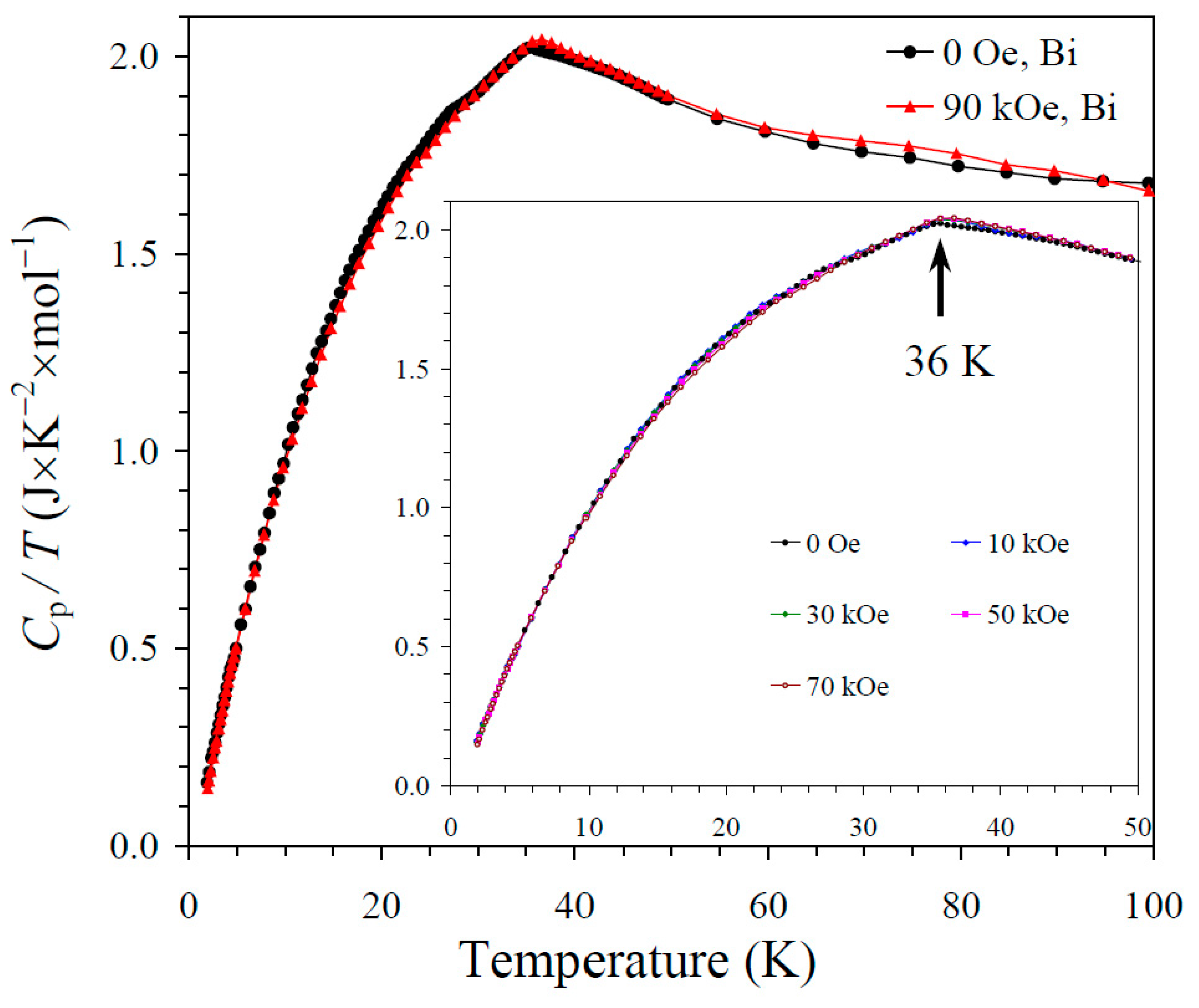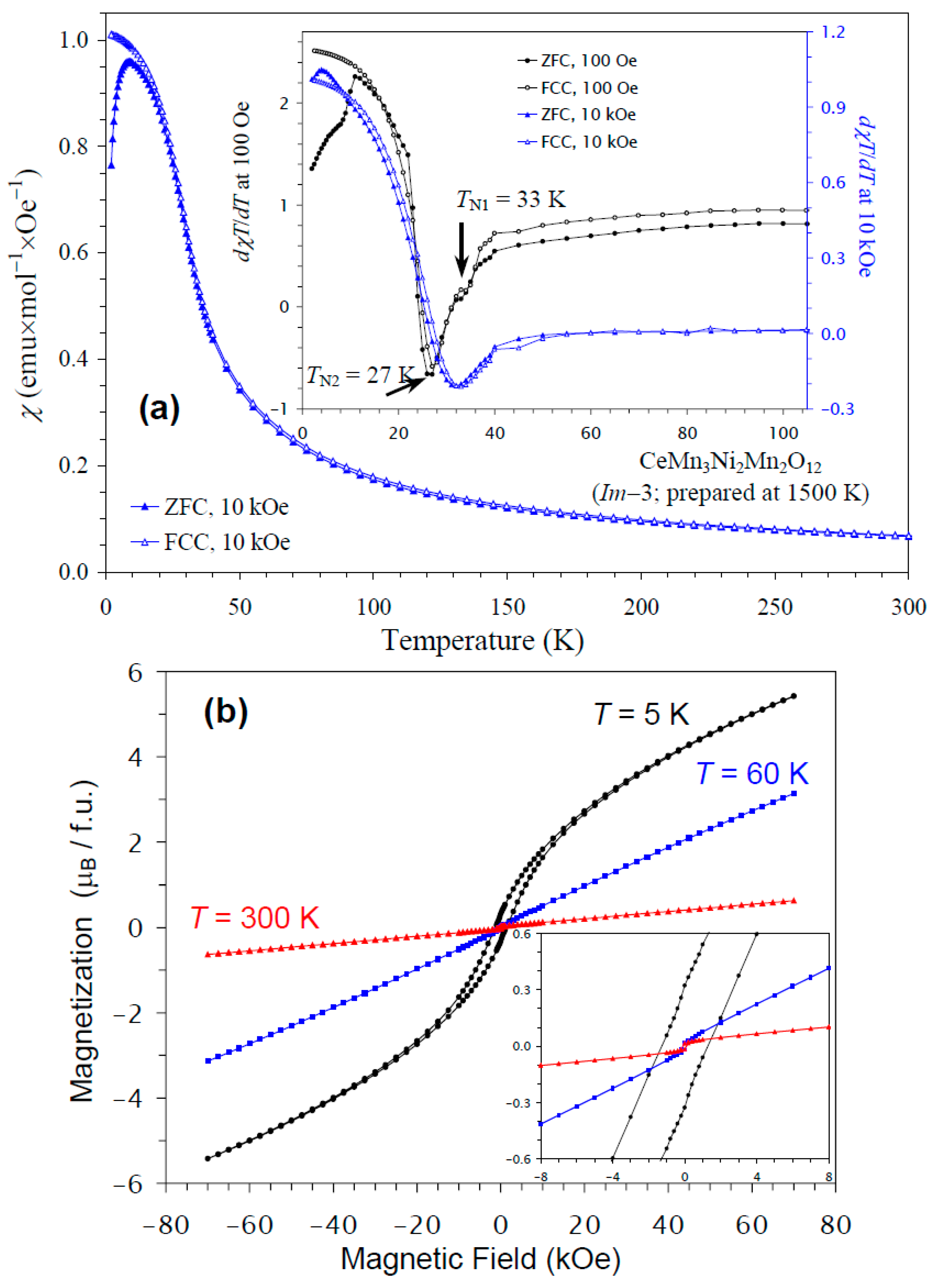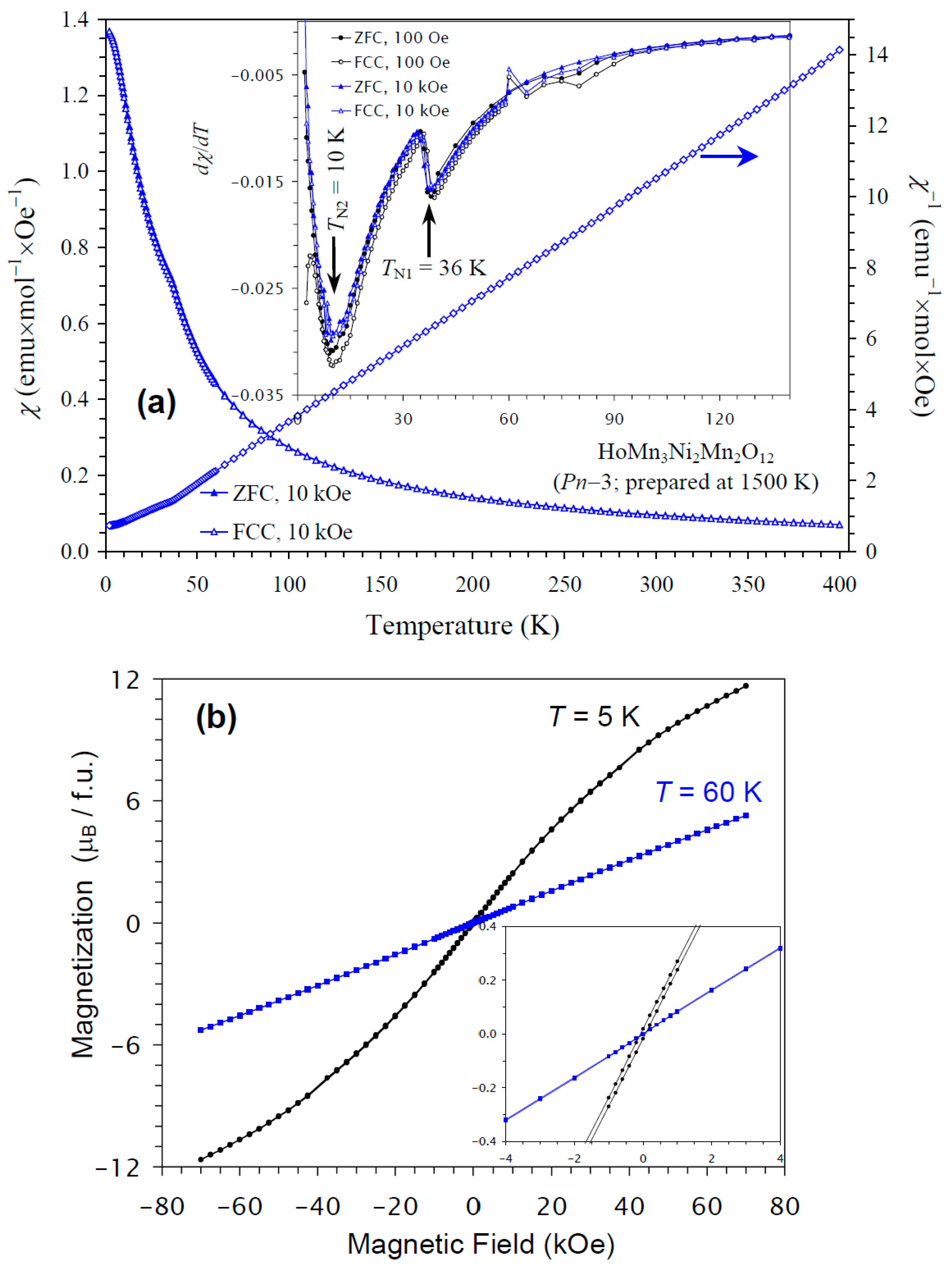A Site-Ordered Quadruple Perovskites, RMn3Ni2Mn2O12 with R = Bi, Ce, and Ho, with Different Degrees of B Site Ordering
Abstract
:1. Introduction
2. Results and Discussion
3. Experimental
4. Conclusions
Supplementary Materials
Funding
Institutional Review Board Statement
Informed Consent Statement
Data Availability Statement
Acknowledgments
Conflicts of Interest
References
- Mitchell, R.H. Perovskites: Modern and Ancient; Almaz Press: Thunder Bay, ON, Canada, 2002. [Google Scholar]
- Abakumov, A.M.; Tsirlin, A.A.; Antipov, E.V. Transition-metal perovskites. In Comprehensive Inorganic Chemistry II (Second Edition): From Elements to Applications; Reedijk, J., Poeppelmeier, K.R., Eds.; Elsevier: Amsterdam, The Netherlands, 2013; Volume 2, pp. 1–40. [Google Scholar]
- Knapp, M.C.; Woodward, P.M. A-site cation ordering in AA′BB′O6 perovskites. J. Solid State Chem. 2006, 179, 1076–1085. [Google Scholar] [CrossRef]
- King, G.; Woodward, P.M. Cation ordering in perovskites. J. Mater. Chem. 2010, 20, 5785–5796. [Google Scholar] [CrossRef]
- Vasala, S.; Karppinen, M. A2B′B″O6 perovskites: A review. Prog. Solid State Chem. 2015, 43, 1–36. [Google Scholar] [CrossRef]
- Bousquet, E.; Cano, A. Non-collinear magnetism in multiferroic perovskites. J. Phys. Condens. Matter 2016, 28, 123001. [Google Scholar] [CrossRef]
- Vasil’ev, A.N.; Volkova, O.S. New functional materials AC3B4O12 (Review). Low Temp. Phys. 2007, 33, 895–914. [Google Scholar] [CrossRef]
- Long, Y. A-site ordered quadruple perovskite oxides AA′3B4O12. Chin. Phys. B 2016, 25, 078108. [Google Scholar] [CrossRef]
- Yamada, I. Novel catalytic properties of quadruple perovskites. Sci. Technol. Adv. Mater. 2017, 18, 541–548. [Google Scholar] [CrossRef] [PubMed]
- Belik, A.A.; Johnson, R.D.; Khalyavin, D.D. The rich physics of A-site-ordered quadruple perovskite manganites AMn7O12. Dalton Trans. 2021, 50, 15458–15472. [Google Scholar] [CrossRef]
- Ding, J.; Zhu, X.H. Research progress on quadruple perovskite oxides. J. Mater. Chem. C 2024, 12, 9510–9561. [Google Scholar] [CrossRef]
- Yin, Y.Y.; Liu, M.; Dai, J.H.; Wang, X.; Zhou, L.; Cao, H.; Cruz, C.D.; Chen, C.T.; Xu, Y.; Shen, X.; et al. LaMn3Ni2Mn2O12: An A- and B-site ordered quadruple perovskite with A-site tuning orthogonal spin ordering. Chem. Mater. 2016, 28, 8988–8996. [Google Scholar] [CrossRef]
- Liu, M.; Hu, C.E.; Cheng, C.; Chen, X.R. A–B-intersite-dependent magnetic order and electronic structure of LaMn3Ni2Mn2O12: A first-principles study. J. Phys. Chem. C 2018, 122, 1946–1954. [Google Scholar] [CrossRef]
- Byeon, S.H.; Lufaso, M.W.; Parise, J.B.; Woodward, P.M.; Hansen, T. High-pressure synthesis and characterization of perovskites with simultaneous ordering of both the A- and B-site cations, CaCu3Ga2M2O12 (M = Sb, Ta). Chem. Mater. 2003, 15, 3798–3804. [Google Scholar] [CrossRef]
- Byeon, S.H.; Lee, S.S.; Parise, J.B.; Woodward, P.M.; Hur, N.H. High-pressure synthesis of metallic perovskite ruthenate Ca-Cu3Ga2Ru2O12. Chem. Mater. 2004, 16, 3697–3701. [Google Scholar] [CrossRef]
- Byeon, S.H.; Lee, S.S.; Parise, J.B.; Woodward, P.M.; Hur, N.H. New ferrimagnetic oxide CaCu3Cr2Sb2O12: High-pressure synthesis, structure, and magnetic properties. Chem. Mater. 2005, 17, 3552–3557. [Google Scholar] [CrossRef]
- Deng, H.S.; Liu, M.; Dai, J.H.; Hu, Z.W.; Kuo, C.Y.; Yin, Y.Y.; Yang, J.Y.; Wang, X.; Zhao, Q.; Xu, Y.; et al. Strong enhancement of spin ordering by A-site magnetic ions in the ferrimagnet CaCu3Fe2Os2O12. Phys. Rev. B 2016, 94, 024414. [Google Scholar] [CrossRef]
- Wang, X.; Liu, Z.; Deng, H.; Agrestini, S.; Chen, K.; Lee, J.F.; Lin, H.J.; Chen, C.T.; Choueikani, F.; Ohresser, P.; et al. Comparative study on the magnetic and transport properties of B-site ordered and disordered CaCu3Fe2Os2O12. Inorg. Chem. 2022, 61, 16929–16935. [Google Scholar] [CrossRef]
- Wang, X.; Liu, M.; Shen, X.D.; Liu, Z.H.; Hu, Z.W.; Chen, K.; Ohresser, P.; Nataf, L.; Baudelet, F.; Lin, H.J.; et al. High-temperature ferrimagnetic half metallicity with wide spin-up energy gap in NaCu3Fe2Os2O12. Inorg. Chem. 2019, 58, 320–326. [Google Scholar] [CrossRef]
- Ye, X.; Liu, Z.; Wang, W.; Hu, Z.; Lin, H.J.; Weng, S.C.; Chen, C.T.; Yu, R.; Tjeng, L.H.; Long, Y.W. High-pressure synthesis and spin glass behavior of a Mn/Ir disordered quadruple perovskite CaCu3Mn2Ir2O12. J. Phys. Condens. Matter 2020, 32, 075701. [Google Scholar] [CrossRef]
- Li, H.P.; Zhang, Q.; Zhu, Z.P.; Ge, Z.Z.; Li, C.S.; Meng, J.; Tian, Y. Unraveling the effect of B-site antisite defects on the electronic and magnetic properties of the quadruple perovskite CaCu3Fe2Nb2O12. Phys. Chem. Chem. Phys. 2019, 21, 3059–3065. [Google Scholar] [CrossRef]
- Guo, J.; Shen, X.D.; Liu, Z.H.; Qin, S.J.; Wang, W.P.; Ye, X.B.; Liu, G.X.; Yu, R.C.; Lin, H.J.; Chen, C.T.; et al. High-pressure synthesis of a B-site Co2+/Mn4+ disordered quadruple perovskite LaMn3Co2Mn2O12. Inorg. Chem. 2020, 59, 12445–12452. [Google Scholar] [CrossRef]
- Liu, Z.; Sun, Q.; Ye, X.; Wang, X.; Zhou, L.; Shen, X.; Chen, K.; Nataf, L.; Baudelet, F.; Agrestini, S.; et al. Quadruple perovskite oxide LaCu3Co2Re2O12: A ferrimagnetic half metal with nearly 100% B-site degree of order. Appl. Phys. Lett. 2020, 117, 152402. [Google Scholar] [CrossRef]
- Li, S.M.; Shu, M.F.; Wang, M.; Pan, C.B.; Zhao, G.C.; Yin, L.H.; Song, W.H.; Yang, J.; Zhu, X.B.; Sun, Y.P. Critical behavior at paramagnetic to ferrimagnetic phase transition in A-site ordered perovskite CaCu3Cr2Nb2O12. Phys. B Condens. Matter 2023, 648, 414376. [Google Scholar] [CrossRef]
- Morimura, A.; Kamiyama, S.; Hayashi, N.; Yamamoto, H.; Yamada, I. High-pressure syntheses, crystal structures, and magnetic properties of novel quadruple perovskite oxides LaMn3Ru2Mn2O12 and LaMn3Ru2Fe2O12. J. Alloys Compd. 2023, 968, 172263. [Google Scholar] [CrossRef]
- Zhang, J.; Liu, Z.H.; Ye, X.B.; Wang, X.; Lu, D.B.; Zhao, H.T.; Pi, M.C.; Chen, C.T.; Chen, J.L.; Kuo, C.Y.; et al. High-pressure synthesis of quadruple perovskite oxide CaCu3Cr2Re2O12 with a high ferrimagnetic Curie temperature. Inorg. Chem. 2024, 63, 3499–3505. [Google Scholar] [CrossRef]
- Kumar, L.; Datta, J.; Sen, S.; Ray, P.P.; Mandal, T.K. Ambient pressure synthesis and properties of LaCu3Fe2TiSbO12: New A-site ordered ferrimagnetic quadruple perovskite. J. Solid State Chem. 2021, 302, 122433. [Google Scholar] [CrossRef]
- Kumar, L.; Sen, S.; Mandal, T.K. Ambient pressure synthesis and structure and magnetic properties of a new A- and B-site ordered multinary quadruple perovskite. Dalton Trans. 2024, 53, 11060–11070. [Google Scholar] [CrossRef]
- Dass, R.I.; Yan, J.Q.; Goodenough, J.B. Oxygen stoichiometry, ferromagnetism, and transport properties of La2−xNiMnO6+δ. Phys. Rev. B 2003, 68, 064415. [Google Scholar] [CrossRef]
- Rogado, N.S.; Li, J.; Sleight, A.W.; Subramanian, M.A. Magnetocapacitance and magnetoresistance near room temperature in a ferromagnetic semiconductor: La2NiMnO6. Adv. Mater. 2005, 17, 2225–2227. [Google Scholar] [CrossRef]
- Kobayashi, Y.; Shiozawa, M.; Sato, K.; Abe, K.; Asai, K. Crystal structure, magnetism, and dielectric properties of La1−xBixNi0.5Mn0.5O3. J. Phys. Soc. Jpn. 2008, 77, 084701. [Google Scholar] [CrossRef]
- Choudhury, D.; Mandal, P.; Mathieu, R.; Hazarika, A.; Rajan, S.; Sundaresan, A.; Waghmare, U.V.; Knut, R.; Karis, O.; Nordblad, P.; et al. Near-room-temperature colossal magnetodielectricity and multiglass properties in partially disordered La2NiMnO6. Phys. Rev. Lett. 2012, 108, 127201. [Google Scholar] [CrossRef]
- Guo, Y.Q.; Shi, L.; Zhou, S.M.; Zhao, J.I.; Liu, W.J. Near room-temperature magnetoresistance effect in double perovskite La2NiMnO6. Appl. Phys. Lett. 2013, 102, 222401. [Google Scholar] [CrossRef]
- Sánchez-Benítez, J.; Martínez-Lope, M.J.; Alonso, J.A.; García-Muñoz, J.L. Magnetic and structural features of the NdNi1−xMnxO3 perovskite series investigated by neutron diffraction. J. Phys. Condens. Matter 2011, 23, 226001. [Google Scholar] [CrossRef]
- Retuerto, M.; Muñoz, Á.; Martínez-Lope, M.J.; Alonso, J.A.; Mompeán, F.J.; Fernández-Díaz, M.T.; Sánchez-Benítez, J. Magnetic interactions in the double perovskites R2NiMnO6 (R = Tb, Ho, Er, Tm) investigated by neutron diffraction. Inorg. Chem. 2015, 54, 10890–10900. [Google Scholar] [CrossRef] [PubMed]
- Booth, R.J.; Fillman, R.; Whitaker, H.; Nag, A.; Tiwari, R.M.; Ramanujachary, K.V.; Gopalakrishnan, J.; Lofland, S.E. An investigation of structural, magnetic and dielectric properties of R2NiMnO6 (R = rare earth, Y). Mater. Res. Bull. 2009, 44, 1559–1564. [Google Scholar] [CrossRef]
- Nasir, M.; Kumar, S.; Patra, N.; Bhattacharya, D.; Jha, S.N.; Basaula, D.R.; Bhatt, S.; Khan, M.; Liu, S.W.; Biring, S.; et al. Role of antisite disorder, rare-earth size, and superexchange angle on band gap, Curie temperature, and magnetization of R2NiMnO6 double perovskites. ACS Appl. Electron. Mater. 2019, 1, 141–153. [Google Scholar] [CrossRef]
- Asai, K.; Fujiyoshi, K.; Nishimori, N.; Satoh, Y.; Kobayashi, Y.; Mizoguchi, M. Magnetic properties of REMe0.5Mn0.5O3 (RE = rare earth element, Me = Ni, Co). J. Phys. Soc. Jpn. 1998, 67, 4218–4228. [Google Scholar] [CrossRef]
- Yi, W.; Liang, Q.F.; Matsushita, Y.; Tanaka, M.; Belik, A.A. High-pressure synthesis, crystal structure, and properties of In2NiMnO6 with antiferromagnetic order and field-induced phase transition. Inorg. Chem. 2013, 52, 14108–14115. [Google Scholar] [CrossRef]
- Terada, N.; Khalyavin, D.D.; Manuel, P.; Yi, W.; Suzuki, H.S.; Tsujii, N.; Imanaka, Y.; Belik, A.A. Ferroelectricity induced by ferriaxial crystal rotation and spin helicity in a B-site-ordered double-perovskite multiferroic In2NiMnO6. Phys. Rev. B 2015, 91, 104413. [Google Scholar] [CrossRef]
- Yi, W.; Princep, A.J.; Guo, Y.F.; Johnson, R.D.; Khalyavin, D.D.; Manuel, P.; Senyshyn, A.; Presniakov, I.A.; Sobolev, A.V.; Matsushita, Y.; et al. Sc2NiMnO6: A double-perovskite with a magnetodielectric response driven by multiple magnetic orders. Inorg. Chem. 2015, 54, 8012–8021. [Google Scholar] [CrossRef]
- Ding, L.; Khalyavin, D.D.; Manuel, P.; Blake, J.; Orlandi, F.; Yi, W.; Belik, A.A. Colossal magnetoresistance in the insulating ferromagnetic double perovskites Tl2NiMnO6: A neutron diffraction study. Acta Mater. 2019, 173, 20–26. [Google Scholar] [CrossRef]
- Sobolev, A.V.; Glazkova, I.S.; Akulenko, A.A.; Sergueev, I.; Chumakov, A.I.; Yi, W.; Belik, A.A.; Presniakov, I.A. 61Ni nuclear forward scattering study of magnetic hyperfine interactions in double perovskites A2NiMnO6 (A = Sc, In, Tl). J. Phys. Chem. 2019, 123, 23628–23634. [Google Scholar] [CrossRef]
- Terada, N.; Colin, C.V.; Qureshi, N.; Hansen, T.; Matsubayashi, K.; Uwatoko, Y.; Belik, A.A. Pressure-induced incommensurate antiferromagnetic order in a ferromagnetic B-site ordered double-perovskite Lu2NiMnO6. Phys. Rev. B 2020, 102, 094412. [Google Scholar] [CrossRef]
- Manna, K.; Bera, A.K.; Jain, M.; Elizabeth, S.; Yusuf, S.M.; Anil Kumar, P.S. Structural-modulation-driven spin canting and reentrant glassy magnetic phase in ferromagnetic Lu2MnNiO6. Phys. Rev. B 2015, 91, 224420. [Google Scholar] [CrossRef]
- Dieguez, O.; Iniguez, J. Multiferroic Bi2NiMnO6 thin films: A computational prediction. Phys. Rev. B 2017, 95, 085129. [Google Scholar] [CrossRef]
- Weihe, H.; Gudel, H.U. Quantitative interpretation of the Goodenough-Kanamori rules: A critical analysis. Inorg. Chem. 1997, 36, 3632–3639. [Google Scholar] [CrossRef]
- Belik, A.A.; Liu, R.; Tanaka, M.; Yamaura, K. B-site-ordered and disordered structures in A-site-ordered quadruple perovskites RMn3Ni2Mn2O12 with R = Nd, Sm, Gd, and Dy. Molecules 2024, 29, 5488. [Google Scholar] [CrossRef] [PubMed]
- Zhou, L.; Dai, J.H.; Chai, Y.S.; Zhang, H.M.; Dong, S.; Cao, H.B.; Calder, S.; Yin, Y.Y.; Wang, X.; Shen, X.D.; et al. Realization of Large Electric Polarization and Strong Magnetoelectric Coupling in BiMn3Cr4O12. Adv. Mater. 2017, 29, 1703435. [Google Scholar] [CrossRef]
- Maia, A.; Kadlec, C.; Savinov, M.; Vilarinho, R.; Moreira, J.A.; Bovtun, V.; Kempa, M.; Míšek, M.; Kaštil, J.; Prokhorov, A.; et al. Can the Ferroelectric Soft Mode Trigger an Antiferromagnetic Phase Transition? J. Eur. Ceram. Soc. 2023, 43, 2479–2487. [Google Scholar] [CrossRef]
- Etter, M.; Isobe, M.; Sakurai, H.; Yaresko, A.; Dinnebier, R.E.; Takagi, H. Charge disproportionation of mixed-valent Cr triggered by Bi lone-pair effect in the A-site-ordered perovskite BiCu3Cr4O12. Phys. Rev. B 2018, 97, 195111. [Google Scholar] [CrossRef]
- Khalyavin, D.D.; Johnson, R.D.; Orlandi, F.; Radaelli, P.G.; Manuel, P.; Belik, A.A. Emergent helical texture of electric dipoles. Science 2020, 369, 680–684. [Google Scholar] [CrossRef]
- Belik, A.A.; Matsushita, Y.; Tanaka, M.; Johnson, R.D.; Khalyavin, D.D. A plethora of structural transitions, distortions and modulations in Cu-doped BiMn7O12 quadruple perovskites. J. Mater. Chem. C 2021, 9, 10232–10242. [Google Scholar] [CrossRef]
- Fu, W.T.; Ijdo, D.J.W. “Unusual” phase transitions in CeAlO3. J. Solid State Chem. 2006, 179, 2732–2738. [Google Scholar] [CrossRef]
- Vasylechko, L.; Senyshyna, A.; Trots, D.; Niewa, R.; Schnelle, W.; Knapp, M. CeAlO3 and Ce1−xRxAlO3 (R = La, Nd) solid solutions: Crystal structure, thermal expansion and phase transitions. J. Solid State Chem. 2007, 180, 1277–1290. [Google Scholar] [CrossRef]
- Errandonea, D.; Santamaria-Perez, D.; Martinez-Garcia, D.; Gomis, O.; Shukla, R.; Achary, S.N.; Tyagi, A.K.; Popescu, C. Pressure impact on the stability and distortion of the crystal structure of CeScO3. Inorg. Chem. 2017, 56, 8363–8371. [Google Scholar] [CrossRef]
- Cao, Y.M.; Cao, S.X.; Ren, W.; Feng, Z.J.; Yuan, S.J.; Kang, B.J.; Lu, B.; Zhang, J.C. Magnetization switching of rare earth orthochromite CeCrO3. Appl. Phys. Lett. 2014, 104, 232405. [Google Scholar] [CrossRef]
- Yuan, S.J.; Cao, Y.M.; Li, L.; Qi, T.F.; Cao, S.X.; Zhang, J.C.; DeLong, L.E.; Cao, G. First-order spin reorientation transition and specific-heat anomaly in CeFeO3. J. Appl. Phys. 2013, 114, 113909. [Google Scholar] [CrossRef]
- Yamada, I.; Etani, H.; Murakami, M.; Hayashi, N.; Kawakami, T.; Mizumaki, M.; Ueda, S.; Abe, H.; Liss, K.D.; Studer, A.J.; et al. Charge-order melting in charge-disproportionated perovskite CeCu3Fe4O12. Inorg. Chem. 2014, 53, 11794–11801. [Google Scholar] [CrossRef] [PubMed]
- Sánchez-Benítez, J.; Martínez-Lope, M.J.; Alonso, J.A. Preparation at moderate pressures, crystal and magnetic structure and magnetotransport of the ferrimagnetic CeCu3Mn4O12 perovskite. J. Appl. Phys. 2010, 107, 103904. [Google Scholar] [CrossRef]
- Kadyrova, N.I.; Zainulin, Y.G.; Tyutyunnik, A.P.; Kellerman, D.G.; Mel’nikova, N.V. Preparation specifics and properties of AMn3V4O12 (A = Ca, Ce, and Sm) high-pressure phases. Russ. J. Inorg. Chem. 2017, 62, 103–110. [Google Scholar] [CrossRef]
- Belik, A.A.; Katsuya, Y.; Tanaka, M.; Yamaura, K. Crystal structure and magnetic properties of A-site-ordered quadruple perovskite CeCu3Cr4O12. J. Alloys Compd. 2019, 793, 42–48. [Google Scholar] [CrossRef]
- Brese, N.E.; O’Keeffe, M. Bond-valence parameters for solids. Acta Crystallogr. Sect. B Struct. Sci. 1991, 47, 192–197. [Google Scholar] [CrossRef]
- Roulhac, P.L.; Palenik, G.J. Bond valence sums in coordination chemistry. The calculation of the oxidation state of cerium in complexes containing cerium bonded only to oxygen. Inorg. Chem. 2003, 42, 118–121. [Google Scholar] [CrossRef] [PubMed]
- Shannon, R.D. Revised effective ionic radii and systematic studies of interatomic distances in halides and chalcogenides. Acta Crystallogr. Sect. A Cryst. Phys. Diffr. Theor. Gen. Crystallogr. 1976, 32, 751–767. [Google Scholar] [CrossRef]
- Pernet, M.; Joubert, J.C.; Ferrand, B. Etude par diffraction neutronique de l’ilmenite ferrimagnetique NiMnO3. Solid State Commun. 1975, 16, 503–508. [Google Scholar] [CrossRef]
- Kittel, C.; McEuen, P. Introduction to Solid State Physics; John Wiley & Sons, Inc.: New York, NY, USA, 2005. [Google Scholar]
- Kawaguchi, S.; Takemoto, M.; Osaka, K.; Nishibori, E.; Moriyoshi, C.; Kubota, Y.; Kuroiwa, Y.; Sugimoto, K. High-throughput powder diffraction measurement system consisting of multiple MYTHEN detectors at beamline BL02B2 of SPring-8. Rev. Sci. Instrum. 2017, 88, 085111. [Google Scholar] [CrossRef]
- Kawaguchi, S.; Takemoto, M.; Tanaka, H.; Hiraide, S.; Sugimoto, K.; Kubota, Y. Fast continuous measurement of synchrotron powder diffraction synchronized with controlling gas and vapour pressures at beamline BL02B2 of SPring-8. J. Synchrotron Rad. 2020, 27, 616–624. [Google Scholar] [CrossRef]
- Izumi, F.; Ikeda, T. A Rietveld-analysis programm RIETAN-98 and its applications to zeolites. Mater. Sci. Forum 2000, 321–324, 198–205. [Google Scholar] [CrossRef]








| Site | WP | g | x | y | z | Biso (Å2) |
|---|---|---|---|---|---|---|
| Ho | 2a | 1 | 0.25 | 0.25 | 0.25 | 0.685(6) |
| MnSQ | 6d | 1 | 0.25 | 0.75 | 0.75 | 0.507(9) |
| Ni1/Mn1 | 4b | 0.815(12)Ni + 0.185Mn | 0 | 0 | 0 | 0.31(3) |
| Mn2/Ni2 | 4c | 0.815Mn + 0.185Ni | 0.5 | 0.5 | 0.5 | 0.29(3) |
| O | 24h | 1 | 0.2578(4) | 0.4242(2) | 0.5567(2) | 0.56(3) |
| R | Bi | Ce |
|---|---|---|
| Wavelength (Å) | 0.4137875 | 0.6200666 |
| Used d-space range (Å) | 0.3122–11.855 | 0.4678–7.108 |
| a (Å) | 7.37294(1) | 7.37071(1) |
| V (Å3) | 400.7949(11) | 400.4314(7) |
| Biso(R) (Å2) | 2.095(9) | 0.565(9) |
| Biso(MnSQ) (Å2) | 0.624(12) | 0.521(12) |
| Biso(Ni/Mn) (Å2) | 0.436(8) | 0.280(9) |
| x(O) | 0.31118(22) | 0.31053(20) |
| y(O) | 0.17728(24) | 0.17562(22) |
| Biso(O) (Å2) | 0.83(4) | 0.62(3) |
| Rwp (%) | 7.54 (6.22) | 8.48 (6.76) |
| Rp (%) | 5.37 (4.56) | 5.73 (4.96) |
| RI (%) | 3.37 (3.49) | 2.87 (3.67) |
| RF (%) | 5.99 (6.03) | 1.58 (2.59) |
| Impurities: | ||
| NiO | 1.9 wt. % | 2.5 wt. % |
| Bi2O2CO3 | 1.4 wt. % | - |
| NiMnO3 | 2.0 wt. % | 5.7 wt. % |
| CeO2 | - | 3.4 wt. % |
| GdFeO3-type | 0.5 wt. % | - |
| R (Symmetry) | TN (K) | μeff (μB/f.u.) | μcalc (μB/f.u.) | θ (K) | MS (μB/f.u.) |
|---|---|---|---|---|---|
| Bi (Im-3) | 36 | 10.899(2) | 10.863 | −55.9(3) | 2.76 |
| Ce (Im-3) | 27, 33 | 11.169(1) | 11.125 | −40.8(2) | 5.42 |
| Ho (Pn-3) | 10, 36 | 15.164(2) | 15.178 | −21.1(1) | 11.66 |
Disclaimer/Publisher’s Note: The statements, opinions and data contained in all publications are solely those of the individual author(s) and contributor(s) and not of MDPI and/or the editor(s). MDPI and/or the editor(s) disclaim responsibility for any injury to people or property resulting from any ideas, methods, instructions or products referred to in the content. |
© 2025 by the author. Licensee MDPI, Basel, Switzerland. This article is an open access article distributed under the terms and conditions of the Creative Commons Attribution (CC BY) license (https://creativecommons.org/licenses/by/4.0/).
Share and Cite
Belik, A.A. A Site-Ordered Quadruple Perovskites, RMn3Ni2Mn2O12 with R = Bi, Ce, and Ho, with Different Degrees of B Site Ordering. Molecules 2025, 30, 1749. https://doi.org/10.3390/molecules30081749
Belik AA. A Site-Ordered Quadruple Perovskites, RMn3Ni2Mn2O12 with R = Bi, Ce, and Ho, with Different Degrees of B Site Ordering. Molecules. 2025; 30(8):1749. https://doi.org/10.3390/molecules30081749
Chicago/Turabian StyleBelik, Alexei A. 2025. "A Site-Ordered Quadruple Perovskites, RMn3Ni2Mn2O12 with R = Bi, Ce, and Ho, with Different Degrees of B Site Ordering" Molecules 30, no. 8: 1749. https://doi.org/10.3390/molecules30081749
APA StyleBelik, A. A. (2025). A Site-Ordered Quadruple Perovskites, RMn3Ni2Mn2O12 with R = Bi, Ce, and Ho, with Different Degrees of B Site Ordering. Molecules, 30(8), 1749. https://doi.org/10.3390/molecules30081749






